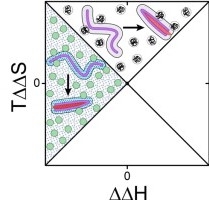
Physical chemistry is concerned with the fundamental principles of chemistry, and serves as the underpinning for all other branches of chemical sciences.
Ph.D. students choose from graduate classes in Molecular Quantum Chemistry, Statistical Thermodynamics, Chemical Kinetics, Condensed Matter Physics, Molecular Dynamics and Biomolecular Simulation, Molecular Spectroscopy.

Tao Ye's group employs scanning probe microscopy to understand how molecules self-assemble at surfaces and interfaces.
Son Nguyen’s group studies the photocatalytic mechanism of metallic nanocrystals via chemical kinetic and spectroscopic methods.
Liang Shi's group employs theory and simulation to study heterogeneous molecular systems for energy applications.

The Thompson Lab combines the techniques of experimental physical chemistry and traditional structural biology to explore the conformational landscapes of protein molecules and identify the structural states and molecular motions that define their biological activities.



